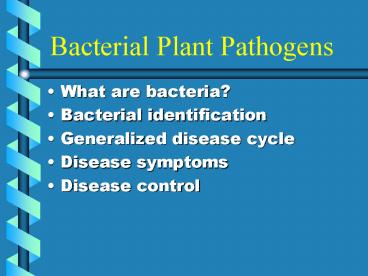Bacterial Plant Pathogens - PowerPoint PPT Presentation
1 / 25
Title:
Bacterial Plant Pathogens
Description:
aerobic, anaerobic, facultative. anaerobic. Nutritional requirement (C, N, {Biolog} ... Most are facultative parasites, Except fastidious bacteria and mollicutes ... – PowerPoint PPT presentation
Number of Views:6137
Avg rating:5.0/5.0
Title: Bacterial Plant Pathogens
1
Bacterial Plant Pathogens
- What are bacteria?
- Bacterial identification
- Generalized disease cycle
- Disease symptoms
- Disease control
2
Bacterial Plant Pathogens
Size (0.3-1.5 x 0.7-5 um )
Generally single celled
Reproduce by simple fission
3
Prokaryotes
No membrane bound nucleus or organelles
Single circular chromosome
Lack chlorophyll
Most have cell wall
Some are motile flagellum (a)
4
Identification
Structure cell shape colony appearance motility
(flagella)
5
Identification
Biochemical cell wall composition
6
Identification
Respiration aerobic, anaerobic, facultative
anaerobic
Nutritional requirement (C, N, Biolog)
Fatty acids FAME
Serology
Nucleic acids
7
Identification
Pathogenicity
8
Plant Pathogenic Bacteria (for PLPA3004)
- 8 genera of bacteria, 1 of uncertain ID
- 2 genera of Mollicutes (lack cell walls
- Approximately 50-60 spp. (200 pathovars pv.)
- Pathovar pathogenic on a specific host (crop)
9
Plant Pathogenic Bacteria (for PLPA3004)
- Most are facultative parasites,
- Except fastidious bacteria and mollicutes
- Most are gram-, rod-shaped bacteria
10
Fastidious vascular bacteria
- Vectored by leafhoppers, except Clavibacter
- Unknown-phloem limited bacterium not culturable
- Symptoms stunting, leaf scalding, decline
- Xylella Pierces disease of grape
11
Mollicutes
- Lack cell wall
- Phloem limited
- Transmitted by leafhoppers
- Phytoplasmas amorphous
- Spiroplasmas - helical
- Symptoms yellows diseases, witches brooming,
stunting - Sensitive to Tetracycline
12
Disease cycle
Overseasoning
2 cycle
o
Reproduction
Dissemination
Disease development
Penetration
13
Disease cycle
Protected environment
14
Disease cycle
- short distance
- 1.Water
- 2. Soil
- 3. Tools and equipment
- 4. Insects
15
Disease cycle
16
Disease cycle
17
Disease cycle
18
Disease cycle
19
Disease control
20
Disease Control
21
Disease Control
22
Disease Control
23
Symptoms
24
Symptoms
25
Symptoms

